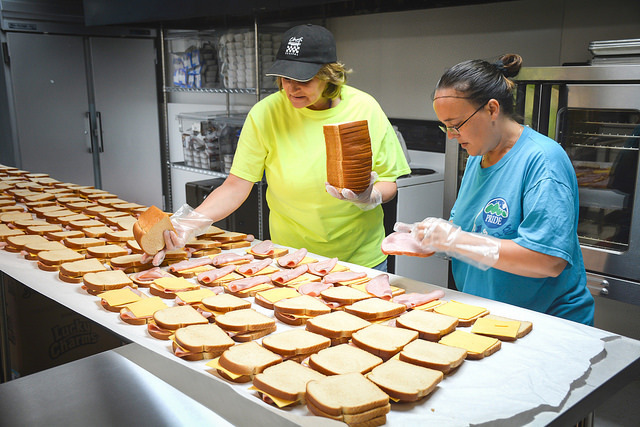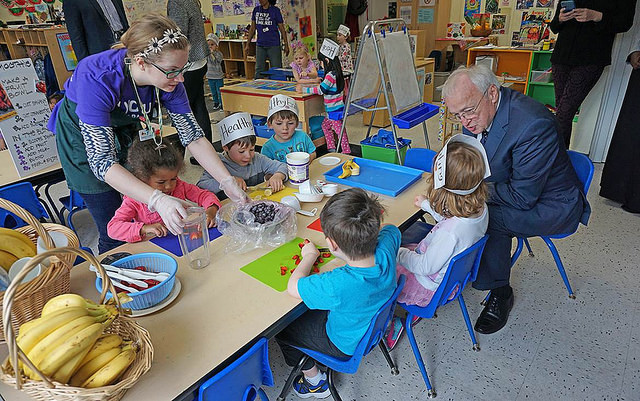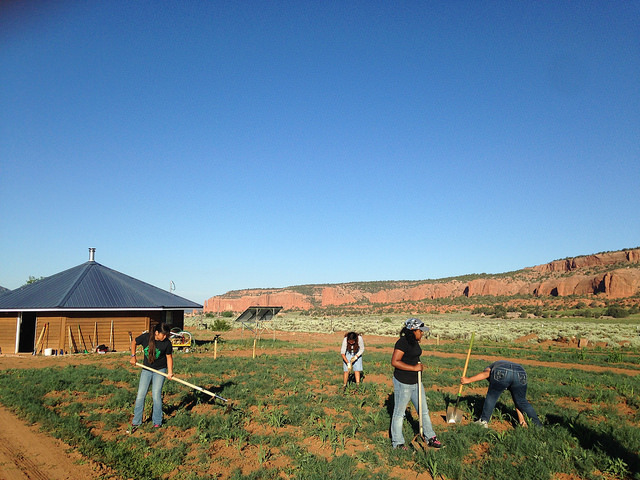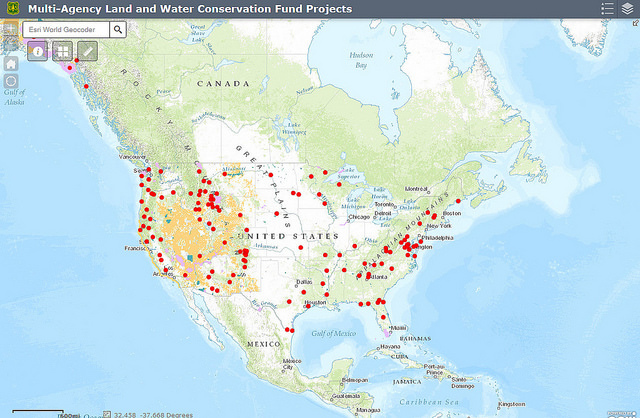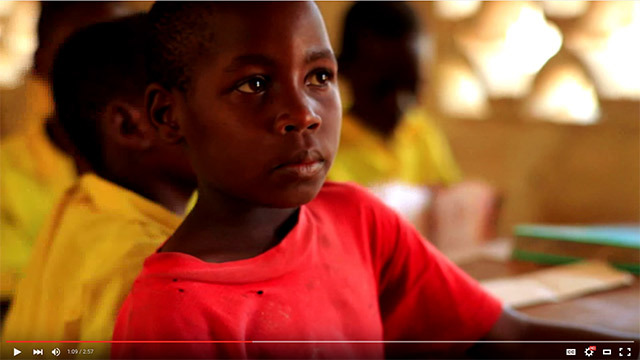Having trouble viewing this email? View it as a Web page.

Building a Better Future for Our Children
ICYMI, here's what happened last week at USDA:
Building a better future for our kids begins with access to nutritious food at home and at school. But we know it takes more than proper nutrition to make sure our kids grow up healthy and strong. Making investments in housing, roads, electricity and broadband, as well as in community facilities, like schools, police departments and hospitals, all work to improve economic opportunities and the quality of life in any community and pave the way toward healthy families from childhood to adulthood.
Last week, Secretary Vilsack traveled to Alabama where he announced a $4.9 million investment in public health and infrastructure projects for rural Alabamans. The projects, ranging from water and wastewater facilities to upgraded police and school facilities, provide access to critical infrastructure for rural Alabama families and businesses and improve overall well-being for residents of the state.
We also announced the 2015 USDA Forest Service's National Urban and Community Forestry Challenge grant recipients. Close to 80% of Americans live in urban areas and depend on the health, economic and social benefits provided by urban trees and forests. The projects chosen will help to enhance urban forest stewardship, and will support new employment opportunities and resilient communities that are responsive to a changing climate. Check to see if there’s a project near you.
Throughout the month of August, we’ll continue to share stories of the many ways USDA works on the ground and with partners to build opportunities for American families and ensure our kids have all the tools they need to grow up healthy and strong. You can take part on Twitter too using #HealthierNextGen.
The Week in Pictures
All images available in Flickr.
On the USDA Blog
Strengthening Rural America For Our Future Generations
Here at USDA, we know that having strong rural communities is critical to ensuring that rural America remains a viable place for families to call home. That’s why, through smart investments and regional partnerships, we continuously work to expand opportunities by fostering the creation of diverse and productive rural economies through everything from home loans to financing for infrastructure and business ventures.
Partners Make Access to Meals for Children Possible Year Round in Kentucky
Kids in bright summer play clothes come running with smiles and laughter as the white cargo van rolls to a stop near a playground and the rear doors swing open. No, it’s not the ice cream truck. It is something better – the lunch ladies from Kentucky Communities Economic Opportunity Council (KCEOC) Community Action Center delivering bagged lunches filled with fruit, sandwiches, juice and milk. Volunteers and staff at KCEOC work hard to feed as many Eastern Kentucky kids as possible during the summer in three USDA StrikeForce counties: Knox, Whitley and Laurel.
Farm to Preschool Helps Healthy Habits Take Root Early
“May I have more kale chips, please?” asked a four-year old preschooler during one of my first site visits as farm to school lead for the Food and Nutrition Service’s Western Region. The preschoolers I was visiting grew and harvested the kale themselves a few feet beyond their classroom door and were enjoying the crisp treat as a snack. At the time, the USDA Farm to School Program was just beginning to expand their support to K-12 schools. Since then, I have worked with school districts in bringing the farm to their cafeterias and classrooms.
Inaugural US Forest Service International Seminar on Forest Landscape Restoration Held in Oregon
Four billion acres of degraded and deforested land world-wide—an area the size of South America—could benefit from restoration. Restoration addresses our most pressing global challenges—from protecting biodiversity to providing food, energy and water, to offering security and economic opportunity for millions of people. In the United States, a multitude of partners from all sectors, from the local to national level, initiated restoration on millions of acres of degraded land, but the United States cannot do it alone.
Improving the Safety of Leafy Greens
Food safety is a top priority for consumers, especially when it comes to the leafy greens in salads. Researchers at the University of Arizona have discovered natural methods to sanitize these vegetables using ingredients commonly found in the kitchen, such as oregano, cinnamon, and vinegar. Plant extracts, essential oils, and organic sanitizers have all proved effective in killing bacteria on leafy greens and extending their shelf life. When emulsified in the water used to wash these leaves, the approach compares to (and sometimes even works better than) bleach or hydrogen peroxide
Tackling Rural Child Poverty In Southwest Georgia
In late July, I was thrilled to visit with leaders from across southwest Georgia, including my hometown of Camilla, to discuss how USDA can support their work on the ground tackling issues relating to rural child poverty. In Georgia, the poverty rate is 19 percent, and for children, it’s a staggering 27 percent. In Dougherty County, nearly one in three residents live in poverty. This is why people like Secretary of Agriculture Vilsack, Secretary of Interior Jewell, and I are hitting the road—to hear first-hand what’s working in rural America and how we, the federal government, can help.
On the Map: The Land, Water and Conservation Fund
There is a Federal program that you may not have heard of, but it is responsible for conserving millions of acres of recreational and conservation lands for Americans to enjoy, and it helps fund local parks, provide access to rivers and trails, and preserve wildlife habitat in every state in the Union. This program is the Land and Water Conservation Fund (LWCF) and each year, the Department of the Interior and Department of Agriculture request funding from Congress to support grants to states and high priority federal recreational and conservation investments. Locating and learning about these special places is now easier than ever through a new interactive map.
Opportunities for Native Youth Available through APHIS’ Safeguarding Natural Heritage Program
The land and our strong ties to the earth as humans are a source of culture and livelihood throughout Indian Country. Native youth carry the hopes of their ancestors forward, and many tribes have visited with me at the Office of Tribal Relations, interested in learning how their children and grandchildren can discover more about the world around them. Through the Animal and Plant Health Inspection Service’s (APHIS) Safeguarding Natural Heritage (SNH) program, the USDA partners with Tribal Colleges and Universities to promote youth exposure to agriculture, natural resources, and wildlife biology.
USDA TV
Read about us in the News
Rural Alabama communities tapped to share nearly $5M in USDA funding (AL.com)
The U.S. Department of Agriculture announced Wednesday rural Alabama investments totaling nearly $5 million that target improved infrastructure and expanded economic opportunities. U.S. Agriculture Secretary Tom Vilsack announced the investments from the city of White Hall in Lowndes County, calling them "vital to protect public health and safety and improve the economic well-being of the state's rural residents."
USDA to contribute $4.9M toward projects in rural Alabama (Birmingham Business Journal)
U.S. Department of Agriculture Secretary Tom Vilsack on Wednesday announced that $4.9 million in funding will be provided to rural communities around Alabama for projects that will protect public health and safety, along with improving water and wastewater infrastructure. Vilsack plans to visit project sites that have already received USDA Rural Development funds, along with participating in the launch of a wastewater treatment facility in White Hall. The USDA contributed a $1,024,000 grant and a $112,000 loan toward the project in White Hall.
Agriculture secretary visits Alabama to tout USDA funding (AL.com)
U.S. Agriculture Secretary Tom Vilsack visited Alabama on Wednesday to help break ground on a wastewater treatment plant in White Hall that was built in part due to $1 million in funding from the agency. The secretary appeared elsewhere in Alabama's 7th Congressional District with U.S. Rep Terri Sewell, D-Birmingham, to tout other projects made possible through USDA funding and to announce an additional $4.9 million in Agriculture Department funding in the area. "I think it would be surprising for folks in the state of Alabama if they knew the USDA invested over $3.8 billion since I've been secretary in a variety of ways," Vilsack said in a phone interview, pointing out that the department provides grants and loans to improve rural economies. "Each one of these projects is obviously a job opportunity…"
Rural Broadband, Fresh Market Opens, Vilsack Visits (Alabama Public Radio)
Rural Alabama residents will finally be able to get broadband internet thanks to an FCC program. It’s called Connect America and its mission is to provide access to high-speed internet everywhere in the country. Mark Wigfield is spokesman for the FCC. He says Windstream Communications is the latest company to come on board with Connect America…U.S. Secretary of Agriculture Tom Vilsack and Congresswoman Terri Sewell are touring parts of Alabama to promote the state's rural small businesses and community infrastructure. The U.S. Department of Agriculture announced that Vilsack attended an event celebrating the groundbreaking of a wastewater treatment facility in White Hall.
Krysta Harden—Camilla native: ‘Tackling Rural Child Poverty In Southwest Georgia’ (SowegaLive)
In late July, I was thrilled to visit with leaders from across southwest Georgia, including my hometown of Camilla, to discuss how USDA can support their work on the ground tackling issues relating to rural child poverty. In Georgia, the poverty rate is 19 percent, and for children, it’s a staggering 27 percent. In Dougherty County, nearly one in three residents live in poverty. This is why people like Secretary of Agriculture Vilsack, Secretary of Interior Jewell, and I are hitting the road—to hear first-hand what’s working in rural America and how we, the federal government, can help.
McGovern-Dole program to feed school children (Argus Leader)
Agriculture Deputy Secretary Krysta Harden on Monday announced that seven new school feeding projects could benefit more than 2.5 million children in Africa and Central America. The projects were awarded as part of the McGovern-Dole International Food for Education and Child Nutrition Program. Through the program, the U.S. Department of Agriculture (USDA) works with private voluntary organizations and foreign governments in developing countries around the globe to reduce hunger and improve literacy and primary education.
USDA providing nearly $50M in grants, loans to spur more North Carolina solar projects (AP/The Republic)
The Obama administration is increasing the number of solar farms sprouting in farm fields across North Carolina. The U.S. Agriculture Department said Friday it is providing nearly $50 million in loans and grants to 13 solar power investments in North Carolina. Link
Listen
NEW INTERNATIONAL SCHOOL FEEDING PROJECTS ANNOUNCED
Broadcast Date: Mon, August 10, 2015
The number two USDA official has announced new international school feeding projects in six countries. She made the announcement from one of those countries in Africa. (Gary Crawford and Krysta Harden)
ACTUALITY: RWANDA LEADERS FULLY IN BACK OF SCHOOL FOOD PROGRAM
Broadcast Date: Mon, August 10, 2015
Krysta Harden, U.S. Deputy Secretary of Agriculture, in Rwanda, saying that the government there is fully backing new school feeding project under the McGovern-Dole International Food for Education and Child Nutrition Program.
A TOOL TO HELP US LOSE WEIGHT AND KEEP IT OFF
Broadcast Date: Wed, August 12, 2015
The Agriculture Department has had for the last ten years a great online site to help us lose weight and now it has a new feature to help us keep the weight off. (Gary Crawford, Corey Holland and Dr. Kevin Hall)
WAYS TO SAVE WITH A FARM ENERGY AUDIT
Broadcast Date: Fri, August 14, 2015
Farm energy audits can help producers save money in more ways than you might think. (Rod Bain and Amanda Marney of University of Missouri Extension)
Share
We are strengthening rural America for future generations and creating a #HealthierNextGen http://t.co/ZLeq44xb4U pic.twitter.com/xkzP6Sst0q
— Dept. of Agriculture (@USDA) August 11, 2015
Grow It, Try It, Like It! Try our nutrition ed. resource for preschoolers → http://t.co/QyTTqVtX2r #HealthierNextGen pic.twitter.com/QZxc1DVUA1
— Dept. of Agriculture (@USDA) August 12, 2015
Help your preschooler eat well, be active, and be healthy! http://t.co/nWbi4EHvrg
— USDA Nutrition (@USDANutrition) August 14, 2015
Learn more about our commitment to improving the health & wellbeing of older adults http://t.co/8Ppz8A3vRD #SNAPWorks pic.twitter.com/1oHDcc2ueA
— USDA Nutrition (@USDANutrition) August 14, 2015
Eating on the go? Use these tips to make healthier choices when eating away from home http://t.co/QbT5ihC4uB #MyPlate pic.twitter.com/hzgEmKin4a
— Let's Move! (@letsmove) August 13, 2015
.@choctawnationOK grows local food access for 1200+ seniors & families with @USDANutrition http://t.co/Q8EXEYkeMj pic.twitter.com/EhzheswrG0
— Dept. of Agriculture (@USDA) August 13, 2015
